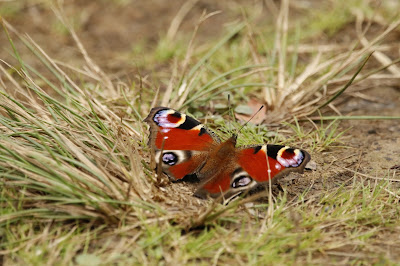There was a cathedral-like hush through the woodland, as at this time of year the birds are quiet and no sound of traffic or human voices could be heard. It was just myself alone in the woods, left to silently walk the paths. And as I wandered in solitary thought, what came to me was the surprise at how open the woods are, at how the sunlight came streaming through the canopy.
The idea of a woodland having a closed canopy is a product of modern day plantations. In the wild forest of yore not many trees would have survived to grow to any great height, due to browsing by wild livestock, such as wild cows, horses or deer. Human beings have replicated this in the form of coppicing, an ancient tradition that mimmicks that browsing. Cutting trees to the ground doesn't kill them, it actually allows them to grow back, but this time with multiple trunks. Ancient human tradition unintentionally mimicking nature for the benefit of both.
You can see examples of coppicing in Wolves Wood, an ancient forest that dates back to the ice age. Just think of all those years covered in trees, never once being cleared and surviving all that time in an agricultural landscape. The woods are an RSPB reserve out east from Ipswich, a large protected area in a rather hostile landscape.
The coppices alternate, the recently cut tree stools allow in lots of light, whilst the older area of copicing is dark, too overgrown to allow any light in. Then there are glades overgrown with THISTLES and MEADOWSWEET and ponds with baby MOORHENS slinking about. And very occasionally there is a tall standard tree looking over the forest. This is a dynamic habitat, constantly on the change, no two areas looking the same.
I had been to Wolves Wood once before, 23 years ago, and considering I live only half an hour away that is pretty bad going. All I have in my defence is that there are so many good reserves to go to in Suffolk I can't possibly visit them all, or maybe its a case of being lazy. Anyway as you can guess I remembered none of it from my last visit so many years ago, so it was all pleasantly new to me.
GREAT SPOTTED WOODPECKER
Being July birdlife was quite noticeably quiet. The usual TIT flocks, ranging family groupings of birds, moving through the forest. At one clearing I got lucky and saw a NUTHATCH, some TREECREEPERS, a couple of MARSH TITS with a GREAT SPOTTED WOODPECKER putting in an appearance. These are all typical ancient woodland species and are good markers of a healthy wood. I would hear and occasionally see these birds in other areas of the forest and it seems there are plenty of birds about.
Nuthatches are quite rare in East Suffolk, despite being common in woodlands in England north up to Scotland. Their absence from this part of the country is a mystery, as they are not fussy birds, liking any sort of woodland, of which East Suffolk has lots. In the end its just some quirk of nature.
PEACOCK butterfly. You can tell this butterfly in flight by its black underwing.
This time of year is probably the best to look for BUTTERFLIES, with Wolves Wood harbouring some species associated with ancient woodland. Unfortunately it wasn't the right weather for butterflies, the air still damp from the rain that had occurred the night before, which the butterflies don't really like. Still sunny days are best for them.
However I did manage to see two species, but unfortunately only one individual of each kind, and none hung around long enough for photographs. One SILVER-WASHED FRITILLERY and one WHITE ADMIRAL which floated up to the canopy were all I saw. There were plenty of the commoner varieties about, often forming clouds as they were disturbed from a cluster of brambles, the most common being PEACOCKS, of which there were loads.
HONEYSUCKLE food plant of the WHITE ADMIRAL
So despite only staying a short time at the reserve I was suitably impressed with my visit to Wolves Wood today. Of course for birds July is out of season, the best time for them and woodland wildflowers is in Spring, so I wasn't expecting to see much, but I saw enough to want a second visit. Of course it won't be long before I come back again, as I am looking to keep my birdwatching as local as possible and this seems a good destination. As always there are many local places that are overlooked, so find a map, find an area of habitat, any kind, and pay a visit, it might be very rewarding.




No comments:
Post a Comment